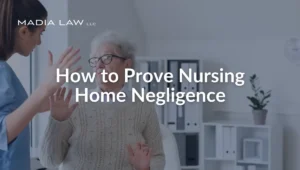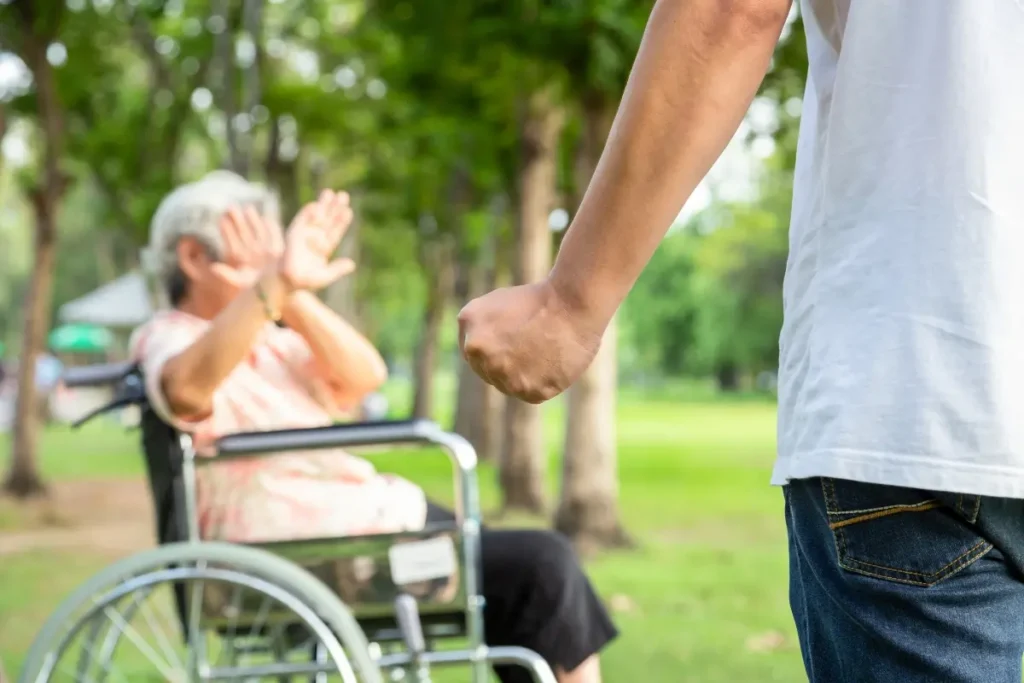
When a loved one’s health suddenly declines in a nursing facility, such as sudden weight loss, bruising, or withdrawal, it signals nursing home negligence. Recognizing these red flags is the first step in protecting their rights.
At Madia Law, we are dedicated to helping Minnesota families hold negligent nursing homes accountable. Our trial lawyers know how to prove nursing home negligence through a thorough investigation, expert medical review, and meticulous courtroom preparation.
If you are concerned about a loved one’s care, we are here to listen and take legal action to protect them.
Key Takeaways From the Blog
- Nursing home negligence happens when a nursing home fails to meet the basic care needs, such as hygiene, nutrition, medication, or safety, and a resident is harmed as a result.
- To prove negligence, you must show four elements: the facility had a duty of care, that duty was breached, the breach caused harm, and the harm resulted in clear damages.
- Key evidence in nursing home negligence often includes medical records, care logs, security footage, inspection reports, and witness statements.
- Damages may include compensation for medical costs, pain and suffering, emotional trauma, wrongful death, and, in severe cases, punitive damages.
- You can take action even without full legal proof by reporting concerns to MAARC, the Minnesota Department of Health, or local authorities.
For a legal consultation, call 612-349-2729
What is Considered Nursing Home Neglect?
Nursing home neglect occurs when a facility fails to meet a resident’s basic needs, like hygiene, nutrition, safety, or medical care, resulting in harm. It involves failure, not intentional abuse.
Minnesota law treats nursing home neglect as a civil wrong when a facility breaches its legal duty to care for a resident’s well-being.
Defining Nursing Home Neglect vs. Abuse
While both are serious matters worth addressing immediately, nursing home neglect and abuse differ in intention and action. Neglect is typically passive, involving the failure by facilities and their staff to provide necessary care. Nursing home abuse involves active harm inflicted by caretakers on clients.
Read more on: What is nursing home abuse?
| Neglect | Abuse |
|---|---|
| Failing to reposition immobile residents | Hitting or slapping a resident |
| Missing meals or medication times | Yelling, threatening, or isolating a resident |
| Not cleaning bed linens regularly | Stealing money or personal items |
| Allowing unsafe conditions to persist | Sexually or physically exploiting a resident |
Neglect often leads to serious injuries and lasting health damage, even when no violence occurs.
Common Examples of Negligence in Nursing Homes
Each of the following reflects a breach of the facility’s legal duty of care:
- Untreated bedsores: Failing to reposition residents violates the duty to prevent pressure injuries.
- Frequent falls: Lack of supervision or safety equipment breaches the obligation to prevent avoidable injuries.
- Malnutrition or dehydration: Ignoring dietary needs violates the duty to maintain resident health.
- Missed medications: Skipping or mismanaging prescriptions breaches medical care standards.
- Poor hygiene: Failing to assist with bathing or toileting breaks the duty to maintain personal cleanliness and dignity.
These signs give you a clear reason to act and collect the proof your case will need.
Legal Elements Required to Prove Negligence
In Minnesota, proving nursing home negligence requires more than showing that a resident was harmed. The law demands that specific legal conditions be met. These conditions form the foundation of all civil injury cases in Minnesota county courts, including claims of elder neglect. When families file a lawsuit, they must prove each part of this four-part test to succeed in court.
| Legal Element | Explanation |
|---|---|
| Duty of Care | The facility had a legal obligation to provide safe care |
| Breach of Duty | Staff failed to meet those standards |
| Causation | The breach directly caused harm |
| Damages | The resident suffered losses (physical, emotional, and financial). |
In a Minnesota nursing home setting, these elements are particularly relevant in situations such as missed medications, failure to supervise fall-risk residents, or ignoring medical symptoms. For example, if staff failed to monitor a diabetic resident’s blood sugar and it led to a coma, the legal team must show that:
- The staff had a duty.
- They failed that duty.
- Their failure caused the harm.
- The resident suffered measurable damage.
All four elements must be supported by strong evidence. If one is missing, the court can dismiss the case. For this reason, the next step, gathering strong, relevant evidence, is critical to every Minnesota nursing home negligence claim.
Click to contact our personal injury lawyers today
What Evidence Do You Need to Prove Negligence in a Nursing Home in Minneapolis?
To prove nursing home negligence in Hennepin County court (or your MN county court of jurisdiction), personal observations alone are not enough. Minnesota law requires hard evidence to support each part of the claim: duty, breach, causation, and damages. Attorneys rely on specific categories of documentation to build a legally sound and persuasive case.
The following sections explain the most important types of evidence. These records not only help prove negligence, but they also often expose larger patterns of poor care within a facility.
Medical Records and Treatment Logs
Medical charts, medication records, and daily treatment logs are critical in nursing home negligence claims. They reveal whether care was delivered on time or missed entirely.
- Example: A gap in charting insulin doses for a diabetic resident shows a breach of care.
- Red flag: Backdated entries or vague language like “resident stable” with no context.
Skilled Minneapolis nursing home attorneys compare these records to the facility’s legal obligations and Minnesota’s care standards. To highlight where care fell short.
Video Footage and Security Monitoring
Surveillance footage provides real-time visual proof of what happened and when. If a resident fell, the video may show whether a staff member was nearby or if the hallway was left unsupervised.
- Tip: Use time-stamped security videos or authorized camera footage to support breach and causation.
- Strategy: Align video with medical entries to expose timeline inconsistencies or false documentation.
This type of evidence often strengthens claims that involve denial of care or facility negligence.
Resident and Staff Testimonies
First-hand accounts provide insight into day-to-day conditions and care patterns. When several people describe the same concerns, eg., missed meals, rough handling, call button delays adds weight to your case.
Government Inspection Reports
State and federal agencies regularly inspect nursing homes. Their findings often provide crucial evidence in cases of elder neglect.
Reports include:
- Deficiencies in staff training or hygiene protocols.
- Repeated violations of safety standards.
- Failure to follow resident care plans.
These third-party documents help show that the facility’s problems were ongoing, not isolated, and known to regulators.
Staffing Records and Daily Care Logs
Understaffing is a common root cause of nursing home negligence. Facilities are legally required to maintain care logs and shift records showing who was on duty and what care was provided.
Red flags:
- Unexplained gaps in staff coverage
- Duplicate or overwritten entries
- Logs showing one aide responsible for too many residents
These records help Minnesota attorneys prove in county courts that the facility failed to meet the required care standard, often directly linking that failure to the resident’s injuries.
Complete a Case Evaluation form now
What Legal Strategies Are Used to Prove Nursing Home Negligence?
Strong evidence is not enough; proving nursing home negligence requires a strategy that connects that evidence to a clear breach of care.
At Madia Law, we build each case by showing where care failed, documenting those failures, and creating a detailed timeline that ties the facts to legal responsibility.
Citing Internal Policy Breaches
Nursing homes are required to follow their own internal policies, and when they do not, it can help prove negligence.
Examples of internal policy violations that support legal claims:
- Not checking on residents hourly as required.
- Ignoring individualized care plans for at-risk residents.
- Skipping scheduled medication rounds.
- Failing to follow fall-response protocols.
- Failing to report and investigate resident complaints.
Attorneys compare what the facility said it would do to what actually happened. This helps prove the care fell below its own standards.
Using Regulatory Standards as Legal Benchmarks
Attorneys often use state and federal regulations to show a nursing home failed to provide reasonable care. These standards define what counts as “reasonable care” in nursing homes across Minnesota.
For example, attorneys may reference:
- Minnesota Department of Health rules for elder care.
- Centers for Medicare & Medicaid Services (CMS) guidelines for nursing facilities.
If the facility’s care falls below these standards, it helps prove a violation of duty.
Establishing Facility-Level Neglect Patterns
Neglect does not always occur in isolation, and it is usually not a one-time mistake. It often reveals bigger problems in how a nursing home is managed or staffed.
Legal teams review past complaints, inspection reports, and public reports to find patterns like:
- Repeated state citations over a period of months or years.
- Multiple resident or family complaints citing the same issues.
- Public data showing systemic underperformance across the facility.
These patterns demonstrate that the problem was not an accident; it was part of ongoing neglect.
Reconstructing Events Through Record Correlation
Building a timeline is a crucial litigation strategy for proving nursing home negligence. Attorneys compare multiple records to show what really happened and when.
They cross-check sources like:
- Care logs
- Video surveillance
- Medical records
- Witness statements
Matching these documents reveals inconsistencies, gaps in care, or signs of staff inaction. A clear timeline helps prove that the facility’s actions or lack of action caused real harm.
How Attorneys Use Evidence to Prove Nursing Home Negligence
In nursing home negligence cases, raw documentation alone is not enough. Attorneys must interpret and connect the facts, like medical data, logs, and witness accounts, to each legal element: duty, breach, causation, and damages.
At Madia Law, we use a strategic framework to turn that evidence into a persuasive case of legal liability.
Analyzing Medical Evidence to Show Substandard Care
Attorneys begin by reviewing treatment records for signs of missed care, such as medication errors or skipped treatments. A missed insulin dose may seem small, but if it leads to a diabetic emergency, it becomes key evidence.
Our team cross-references:
- Symptom progression
- Medical protocols
- Daily care logs
This comparison reveals where the care fell short of acceptable standards.
Aligning Timelines Across Surveillance and Records
To prove nursing home negligence, attorneys compare surveillance footage, staff logs, and care notes to build an accurate timeline.
- Video surveillance timestamps
- Staff schedules
- Nurse’s notes
- Call light response times
If logs say staff checked every 15 minutes, but video shows a resident was left unattended for an hour, that is a serious discrepancy. Timelines with conflicting information like this help challenge the facility’s claims and prove care failures.
Leveraging Testimony to Support Causation
Strong cases rely on verified, consistent testimony, not hearsay. Attorneys gather sworn statements from:
- Staff
- Residents
- Family members
These accounts are matched to the case timeline to confirm facts, expose contradictions, and demonstrate how neglect contributed to the injury. Verified testimony adds credibility to your case in court.
Presenting Expert Opinions to Prove Liability
When medical records need interpretation, attorneys bring in an expert who understands nursing home standards. These experts may include:
- Geriatric care professionals
- Licensed nurses
- Long-term care administrators
Experts explain what a reasonable caregiver should have done and how the care failed. Their insight helps turn technical findings into clear, courtroom evidence.
Example: “A wound that advanced from Stage I to Stage III in less than 72 hours suggests failure in pressure ulcer protocol adherence.” – Geriatric RN Consultant
Driving Case Resolution with Strategic Evidence Use
Attorneys do not just collect evidence; they organize to strengthen your case during settlement or trial. A strong case file may include:
- A detailed event timeline.
- Medical records cross-checked for gaps.
- State and federal care violations
- Verified testimony.
This type of evidence builds legal pressure and often leads to more favorable settlements or courtroom success. It is how attorneys fight for both justice and compensation.
What Types of Lawsuits Can You File for Nursing Home Negligence?
Our attorneys handle all major types of nursing home abuse and neglect cases in Minnesota.
Each type of lawsuit below involves a serious breakdown in care and may qualify for legal action if harm occurred:
| Type of Abuse | Description |
|---|---|
| Sexual Abuse | Any unwanted sexual contact or exploitation of vulnerable residents. |
| Physical Abuse | Hitting, pushing, or using force that causes injury or pain. |
| Mental Abuse | Verbal threats, humiliation, isolation, or manipulation that harm emotional well-being. |
| Financial Abuse | Theft, fraud, or misuse of a resident’s money, account, or personal property. |
| Medication Errors | Providing the wrong drug or skipping doses often leads to medical harm. |
| Wrongful Death | Fatalities caused by preventable errors, delayed treatment, or lack of proper care. |
| Weight Loss & Malnutrition | Significant weight loss or dehydration due to skipped meals or ignored dietary needs. |
Some cases involve more than one type of abuse. Our attorneys will examine your family’s situation and advise on the strongest legal path forward.
Steps to Take If You Suspect Nursing Home Abuse in Minneapolis
When something feels wrong in a care facility, even if you are unsure of precisely what is happening, early action is essential. Even without proof, you can begin gathering facts and protecting your loved one.
Initial Actions to Take Before Reporting
Before making a formal complaint:
- Document the Concerns: Take photos of injuries, unsanitary conditions, or safety issues.
- Record Dates and Times: Log when problems occurred and how staff responded.
- Speak with the Staff: Ask direct but respectful questions about care procedures and recent changes.
- Gather Witness Input: Talk with other residents or visiting family members who may have seen the same issues.
Who to Contact in Minneapolis
Once you have gathered basic details, you can file an official report.
- Emergency or Immediate Danger: Call 911 right away if a resident is in immediate danger.
- Report Suspected Abuse: Minnesota Adult Abuse Reporting Center (MAARC), call 1-844-880-1574. Report suspected abuse, neglect, or exploitation of vulnerable adults.
- State Oversight for Care Facilities: Minnesota Department of Health (MDH). File a complaint online about facility licensing violations or poor care.
- Facility Contacts: Contact the nursing home administrator or director of nursing to initiate an internal review. Ask for written responses.
Can I Sue a Nursing Home for Neglect?
Yes, legal action can be taken against a nursing home in Minnesota when neglect leads to harm. Once nursing home negligence is proven through evidence, you may have grounds to file a civil lawsuit for damages. This is the legal step that moves your case from proof of neglect to accountability and justice.
Two key questions determine your eligibility to sue:
- Does the neglect meet Minnesota’s legal standard for a lawsuit?
- Are you legally allowed to bring the case on behalf of the resident?
When Neglect Meets the Legal Standard for a Lawsuit
Not every instance of poor care is legally actionable. For a successful lawsuit, Minnesota law requires more than minor lapses, and that these lapses show a pattern or severity of neglect that caused measurable harm.
Use the checklist below to assess if your case meets the legal threshold:
- Documented breach of care (e.g., missed medications, lack of supervision).
- Evidence of serious injury or harm (e.g., infection, fall injury, emotional trauma).
- Pattern of repeated problems (e.g., past citations, other resident complaints).
- Proof that neglect directly caused the harm.
- Records or testimony supporting your claim.
If your situation checks these boxes, it likely meets the threshold for a valid claim under Minnesota civil law.
Statute of Limitations in Minnesota Negligence Cases
Under Minnesota Statute § 541.07, you generally have two years from the date of the injury or discovery of the neglect to file a claim.
Exceptions or tolling periods may apply:
- If the victim is mentally incapacitated, the timeline may pause.
- If the injury was discovered later, the clock may start from the date of discovery.
- Wrongful death claims may follow a different timeline, usually three years from the date of death.
Because statutes can be complex, it is important to speak with an attorney as soon as you suspect negligence.
Who Can Legally Sue a Nursing Home in Minnesota?
To sue a nursing home in Minnesota, you must have legal standing, meaning a direct connection to the harmed resident.
You can file a lawsuit if you are the:
- The resident who was injured.
- Spouse of the resident.
- Adult child or close relative.
- Legal guardian.
- Estate representative in wrongful death cases.
If you are unsure whether you qualify, a Minnesota nursing home abuse lawyer can clarify your legal rights.
How Much Compensation Can You Recover After Proving Nursing Home Negligence?
Once nursing home negligence is legally established, the next step is determining the full scope of compensation. Damages may include more than just medical bills; many Minnesota families recover financial awards for pain, emotional trauma, and even wrongful death.
Common compensation types include:
- Medical expenses related to injuries caused by neglect.
- Pain and suffering from preventable conditions like bedsores or falls.
- Emotional distress due to isolation, fear, or psychological abuse.
- Wrongful death damages in fatal elder neglect cases.
- Punitive damages were awarded when the facility’s actions were especially reckless.
In some cases, jury awards and settlements have reached substantial figures. Here is a nursing home negligence case result that led to high compensation secured by us for our client.
Calculating nursing home abuse compensation in Minnesota takes legal experience. Talk to our Minneapolis-based attorneys to find out what your case may be worth, based on actual harm, legal standards, and available evidence.
How to Report Suspected Abuse Before You Have Legal Proof
Reporting abuse starts with knowing where and how to act. If you suspect neglect or mistreatment:
- Call MAARC at 1-844-8-80-1574 for urgent elder abuse reporting.
- Submit a complaint to the Minnesota Department of Health about care violations.
- Inform the facility administrator to document your concerns internally.
- Contact local law enforcement if you believe a crime or immediate danger exists.
Do not wait for full proof; document what you can and alert the proper authorities early.
Why Choose Madia Law for a Nursing Home Negligence Case in Minnesota?
Choosing the right legal team matters. At Madia Law LLC, we fight elder abuse cases not just by filing paperwork, but by applying our extensive courtroom experience and proven ability to secure significant trial wins.
Why families trust us:
- Deep experience in elder neglect litigation.
- Proven case results in court and settlement.
- Clear communication throughout your case.
- No fees unless we win.
We are ready to take your case as far as needed, including trial.
Speak With a Nursing Home Abuse Lawyer in Minneapolis Now
If you believe a loved one is suffering from neglect, now is the time to act. Delays can worsen harm and complicate the legal process. Headquartered in the Twin Cities and proudly serving the Land of 10,000 Lakes, Madia Law LLC is prepared to investigate, build your case, and pursue full accountability.
To speak with our experienced nursing home lawyer in Minneapolis, call now or fill out our form. Your family’s safety deserves action today.
Call 612-349-2729 or complete a Case Evaluation form




